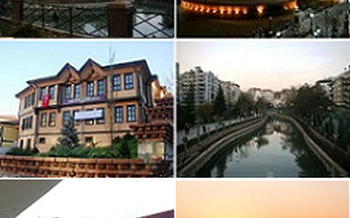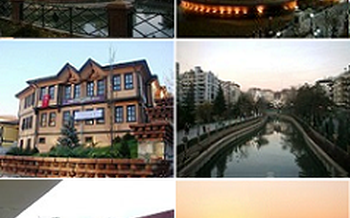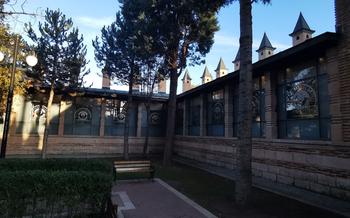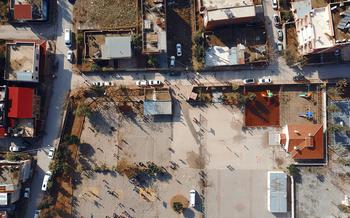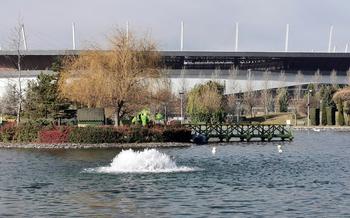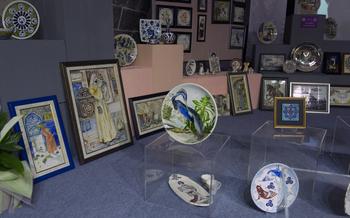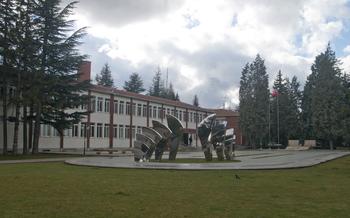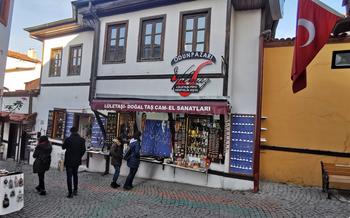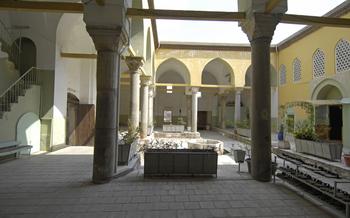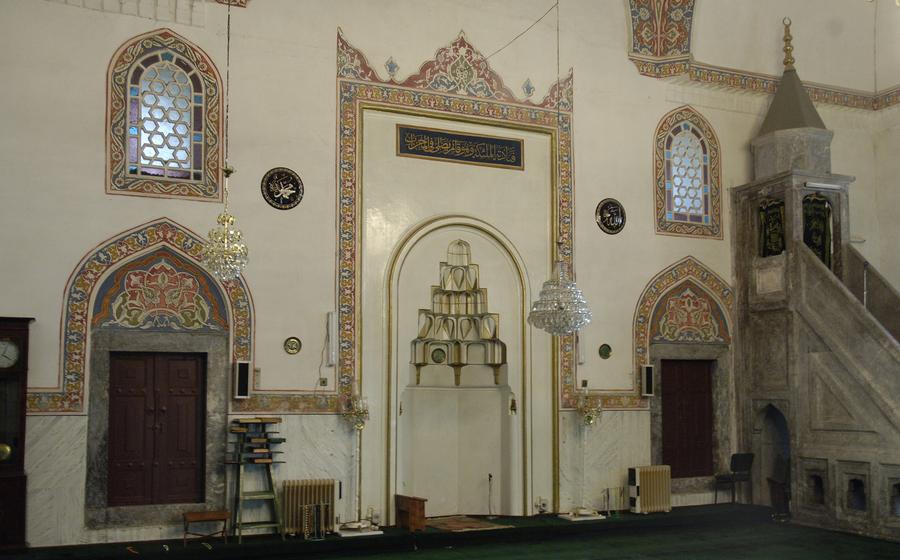
Kurşunlu Mosque and Complex
- History of the Kurşunlu Mosque and Complex
- Location:
- Architecture
- Interior Decorations
- Courtyard and Gardens
- Prayer Hall
- Religious Significance
- Cultural Importance:
- Visiting Hours
- Admission Fee
- Dress Code
- Photography
- Guided Tours
- Nearby Attractions:
- Insider Tip:
History of the Kurşunlu Mosque and Complex
The Kurşunlu Mosque and Complex, also known as the Kurşunlu Külliyesi, is a historical and architectural marvel located in the heart of Eskişehir, Turkey. Built in the 16th century during the reign of Sultan Süleyman the Magnificent, the mosque stands as a testament to the grandeur of Ottoman architecture and the rich cultural heritage of the city.
The complex encompasses the mosque, a medrese (Islamic school), a hamam (bathhouse), a caravanserai (inn), and a soup kitchen, reflecting the Ottoman tradition of külliye, where religious and social institutions were built together to serve the community. The mosque's name, "Kurşunlu," derives from the lead-covered domes that adorn its roof, a unique feature that sets it apart from other mosques in the region.
The Kurşunlu Mosque boasts an impressive blend of architectural styles, showcasing the mastery of Ottoman builders. Its main dome, supported by four massive pillars, dominates the skyline and is a striking example of classical Ottoman architecture. The intricate tilework and calligraphy on the interior walls and mihrab (prayer niche) are reminiscent of the exquisite craftsmanship that characterized the era.
Over the centuries, the Kurşunlu Mosque has undergone several renovations and restorations, preserving its original beauty and grandeur. In the 19th century, the mosque was extensively restored by the order of Sultan Abdülmecid, who added new features such as the minaret and the clock tower. These additions further enhanced the mosque's architectural significance, making it one of the most iconic landmarks of Eskişehir.
Location:
The Kurşunlu Mosque and Complex is conveniently situated in the heart of Eskişehir, at Kurabiyelik Caddesi No:125, Odunpazarı, 26030. This prime location makes it easily accessible by foot or public transportation. For those arriving by car, ample parking spaces are available nearby. The mosque stands proudly amidst other historical landmarks, inviting visitors to immerse themselves in the rich cultural heritage of Eskişehir. Within walking distance, you'll find the enchanting Odunpazarı district, brimming with traditional Ottoman houses, quaint cafes, and charming boutiques. Don't miss the opportunity to explore this vibrant neighborhood after your visit to the mosque.
Architecture
The Kurşunlu Mosque stands as a testament to the grandeur of Ottoman architecture, showcasing a harmonious blend of intricate craftsmanship and elegant design. Its distinctive dome, a symbol of Islamic architecture, dominates the skyline, while its slender minaret, adorned with intricate tilework, points heavenward like a beacon of faith.
The exterior of the mosque is adorned with exquisite tilework, featuring vibrant colors and intricate geometric patterns that narrate stories from the Quran and Islamic history. Calligraphy, an art form revered in Islamic culture, graces the walls, with verses from the holy book inscribed in flowing Arabic script.
The mosque's overall design reflects the quintessential features of Ottoman style, characterized by its symmetry, balance, and attention to detail. Every element, from the arched doorways to the delicate ornamentation, contributes to the mosque's majestic presence.
Interior Decorations
Step inside the Kurşunlu Mosque, and you'll be greeted by a symphony of colors and intricate details. The mihrab, the niche indicating the direction of Mecca, is a masterpiece of Islamic art, adorned with vibrant tiles and calligraphy that seems to dance across the surface. The minbar, the pulpit from which the imam delivers sermons, is equally impressive, showcasing fine woodwork and intricate carvings.
Look up, and your eyes will be drawn to the stained glass windows, which bathe the interior with a warm, ethereal light. Each window is a unique work of art, depicting scenes from Islamic history and culture. The chandeliers, suspended from the high ceiling, are another sight to behold, their delicate crystals reflecting the light in a myriad of colors.
The carpets, which cover the floor of the prayer hall, are a testament to the skill and artistry of Turkish weavers. Their intricate patterns and rich colors add to the overall beauty and serenity of the space. Every element of the mosque's interior has been carefully designed to create an atmosphere of awe and inspiration, inviting visitors to connect with the divine.
Courtyard and Gardens
The Kurşunlu Mosque complex boasts a serene courtyard surrounded by lush gardens that invite visitors to find solace and tranquility. The courtyard provides a welcoming space for worshippers and tourists alike to pause, reflect, and appreciate the beauty of nature. At the center of the courtyard stands an ablution fountain, a vital element in Islamic architecture, where visitors can perform the ritual cleansing before their prayers. The surrounding gardens are adorned with a variety of trees, flowers, and plants, creating a vibrant and colorful oasis. The fragrance of roses, jasmine, and herbs fills the air, enhancing the spiritual atmosphere of the mosque complex. Visitors can take a leisurely stroll through the gardens, admiring the vibrant flora and the intricate designs of the walkways, or simply sit on one of the benches and soak in the peaceful ambiance.
Prayer Hall
The prayer hall of the Kurşunlu Mosque is a sight to behold, with its spacious interior and capacity to accommodate hundreds of worshippers. The hall is designed to foster spiritual reflection and tranquility, with its calming acoustics and serene atmosphere. The intricate designs and patterns adorning the walls and ceiling create a visually captivating space that enhances the spiritual experience.
The prayer hall is divided into separate sections for men and women, a common feature in many mosques. This division allows for a more focused and dedicated prayer experience for both genders. The mihrab, a niche in the wall indicating the direction of Mecca, is adorned with intricate tilework and calligraphy, guiding the worshippers towards the qibla. The minbar, a raised platform used for delivering sermons, is another notable feature of the prayer hall, showcasing fine craftsmanship and adding to the overall grandeur of the space.
Religious Significance
The Kurşunlu Mosque holds immense religious significance for the Muslim community of Eskişehir. It serves as a sacred place of worship, where daily prayers and religious ceremonies are held. The mosque's spacious prayer hall can accommodate hundreds of worshippers, providing a serene and spiritual environment for them to connect with their faith. The mosque also acts as a community center, fostering a sense of unity and belonging among the Muslim residents. It is a place where they can gather for religious events, celebrations, and discussions. The mosque's religious significance extends beyond the local community, attracting Muslim visitors from across Turkey and beyond, who come to admire its beauty and experience the spiritual atmosphere it offers.
Cultural Importance:
The Kurşunlu Mosque and Complex holds immense cultural significance for Eskişehir and beyond. It stands as a testament to the city's rich history and architectural heritage. The mosque's unique Ottoman style, intricate tilework, and stunning calligraphy reflect the artistry and craftsmanship of the era. It serves as a living example of Turkish Islamic art and architecture, showcasing the fusion of Islamic traditions with local Anatolian influences.
The mosque's cultural importance extends beyond its physical structure. It plays a vital role in the community, serving as a place for religious worship, social gatherings, and education. Locals gather here for daily prayers, religious ceremonies, and events, fostering a sense of unity and belonging. The mosque also hosts educational programs, workshops, and exhibitions, promoting the preservation and appreciation of Islamic culture and heritage.
Visiting Hours
The Kurşunlu Mosque welcomes visitors with open arms, encouraging them to immerse themselves in its tranquility and beauty. To ensure a peaceful and enriching experience, the mosque adheres to specific visiting hours.
During the week, the mosque is open from 9:00 AM to 6:00 PM, providing ample time for exploration and reflection. However, it is crucial to note that during prayer times, which occur five times a day, the mosque temporarily closes to non-worshippers. These prayer times typically last for about 30 minutes, allowing the faithful to fully engage in their spiritual practices.
On Fridays, the mosque observes a slightly different schedule due to the weekly congregational prayer, known as the Jummah prayer. On this day, the mosque opens later at 1:00 PM, giving worshippers sufficient time to prepare for the special service.
To make the most of your visit, it is advisable to plan your arrival between prayer times or during the early morning hours. This allows you to wander through the mosque's serene spaces without disturbing ongoing prayers and fully appreciate its architectural wonders.
Admission Fee
Visiting the Kurşunlu Mosque and Complex is free of charge for all visitors, regardless of their religious affiliation or nationality. This open-door policy reflects the mosque's welcoming spirit and its commitment to fostering interfaith understanding and cultural exchange. Whether you are a devout Muslim seeking a spiritual retreat or a curious traveler eager to delve into Turkish Islamic architecture, you are invited to step into the mosque's sacred space without any financial barriers.
Dress Code
Visitors to the Kurşunlu Mosque are expected to dress respectfully, in accordance with Islamic customs and traditions. This means covering your shoulders and knees, and avoiding any clothing that is too revealing or tight-fitting. Women are also advised to cover their hair with a headscarf. While it is not mandatory for non-Muslim visitors to wear a headscarf, it is a sign of respect for the local culture and religion. You can purchase a headscarf from one of the many vendors near the mosque if you do not have one. By dressing modestly, you will show respect for the sacred nature of the mosque and help to create a welcoming environment for all visitors.
Photography
The Kurşunlu Mosque welcomes photography enthusiasts to capture the beauty of its architecture and interiors. However, certain guidelines must be followed to ensure respect and maintain the sanctity of the religious space. Photography is generally allowed in the courtyard, exterior, and common areas of the mosque. However, visitors are requested to refrain from taking photos inside the prayer hall during prayer times or when worshippers are present. Using flash photography is also discouraged to avoid disturbing the worshippers. It's important to be mindful of the privacy of others and seek permission before photographing individuals, especially women. Remember, the mosque is a place of worship, and respectful behavior is expected from all visitors.
Guided Tours
The Kurşunlu Mosque offers guided tours for visitors who wish to delve deeper into its history, architecture, and religious significance. These tours are conducted by knowledgeable guides who provide insightful commentary and anecdotes about the mosque. They will point out the mosque's unique features, explain the symbolism behind the intricate tilework and calligraphy, and share stories about the mosque's role in the community.
Joining a guided tour is an excellent way to make the most of your visit to the Kurşunlu Mosque. Tours are available in several languages, including English, Turkish, and Arabic. To book a tour, you can contact the mosque directly or check with your hotel or travel agency.
Here's a personal anecdote about a guided tour I took at the Kurşunlu Mosque: I joined a guided tour in English, and our guide, a passionate historian, brought the mosque's history to life. He shared fascinating stories about the mosque's construction, its role during the Ottoman Empire, and its restoration in the 20th century. The tour was informative and engaging, and I highly recommend it to anyone visiting the mosque.
Nearby Attractions:
The Kurşunlu Mosque and Complex is surrounded by a wealth of historical and cultural attractions that invite further exploration. Take a short stroll to the Porsuk River, where you can admire the scenic views and visit the Eskişehir Modern Glass Art Museum. For a glimpse into the city's past, wander through the Odunpazarı district, renowned for its well-preserved Ottoman-era houses and charming cobblestone streets. Be sure to visit the ETİ Arkeoloji Müzesi, which houses an impressive collection of archaeological artifacts from the region. For a touch of contemporary art, head to the Çağdaş Sanat Müzesi, showcasing works by both local and international artists.
Insider Tip:
One of the most fascinating things about the Kurşunlu Mosque is its hidden courtyard, tucked away behind the main prayer hall. This serene oasis offers a moment of tranquility amidst the bustling city. Visitors can wander through the lush gardens, admire the intricate tilework on the walls, and listen to the soothing sound of the water fountain. It's the perfect place to escape the crowds and reflect on the beauty and spirituality of the mosque. Be sure to take some time to explore this hidden gem during your visit.
